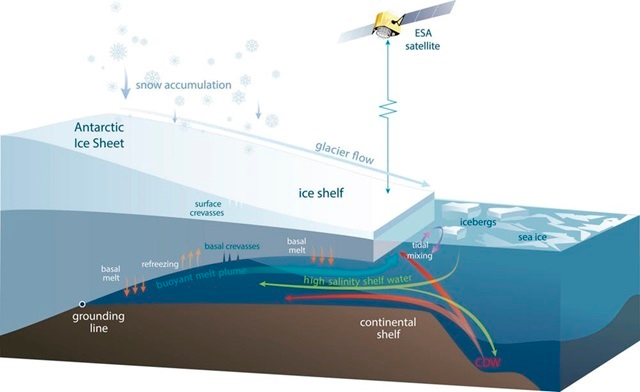Mar 3 2020
A recent study published in the journal Nature has explored the physics behind the warming ocean currents around the Antarctic coast, finding floating ice walls offer some protection to the ice sheet by limiting the amount of ocean heat that reaches the ice.
 Diagram of an Antarctic ice shelf showing the processes causing the volume changes measured by satellites. Ice is added to the ice shelf by glaciers flowing off the continent and by snowfall that compresses to form ice. Ice is lost when icebergs break off the ice front, and by melting in some regions as warm water flows into the ocean cavity under the ice shelf. Under some ice shelves, cold and fresh meltwater rises to a point where it refreezes onto the ice shelf.
Diagram of an Antarctic ice shelf showing the processes causing the volume changes measured by satellites. Ice is added to the ice shelf by glaciers flowing off the continent and by snowfall that compresses to form ice. Ice is lost when icebergs break off the ice front, and by melting in some regions as warm water flows into the ocean cavity under the ice shelf. Under some ice shelves, cold and fresh meltwater rises to a point where it refreezes onto the ice shelf.
The research was led by the University of Gothenburg and used data and research from Australia’s National Science Agency, CSIRO.
Floating ice walls – the edge of the floating ice shelf – are connected to landmass. Icebergs detach from ice shelves to join the ocean.
The Antarctic ice sheet contains enough ice, if melted, to raise global sea levels by tens of metres so improving our understanding of the stability of the Antarctic ice sheet - and the processes which could slow or speed its rate of melt - are of critical importance globally.
Researchers found that floating ice walls partly deflect warm ocean currents that would otherwise penetrate cavities beneath the floating portions of the ice sheet.
CSIRO researcher at the Centre for Southern Hemisphere Ocean Research (CSHOR), Dr Laura Herraiz-Borreguero said one important control on ice loss from Antarctica was what happened where the ice sheet meets the ocean, where a large amount of ice melts.
“The Antarctic ice sheet reaches the ocean through ice shelves, which are the floating edges of the ice sheet,” Dr Herraiz-Borreguero said.
“Like a dam wall, these ice shelves slow down the rate at which grounded ice is discharged to the ocean, where it melts and contributes to sea level rise.”
The question of how warm ocean currents made their way to the ice sheet, beneath the floating ice shelves, has been a long unanswered question for researchers.
More knowledge has now been obtained by studying data collected from instruments that Dr Herraiz-Borreguero and her colleagues placed in the ocean in front of Getz glacier ice shelf in West Antarctica.
The Getz glacier culminates in a vertical edge, a floating wall of ice that continues 300 to 400 metres down into the ocean.
Warm ocean currents flow beneath this edge, towards the deeper grounded ice.
The researchers found that the warm ocean currents were blocked by the floating ice edge, which limited the extent to which the warm ocean could reach the ice.
The floating ice blocks about two thirds of the thermal energy carried by the ocean currents, which travels up towards the Antarctic ice sheet from the deep Southern Ocean.
The results of the study have provided researchers with a greater understanding of how glacier areas like the Getz work.
“Our work highlights the importance of the floating ice shelves, and in particular, their ice fronts, as key areas that should be closely monitored,” Dr Herraiz-Borreguero said.
“If the ice front walls were to thin and disappear, a much greater portion of ocean heat would be delivered towards the grounded Antarctic ice.”
Researchers believe the studies provided them with significantly better tools to be able to predict future sea level rise.